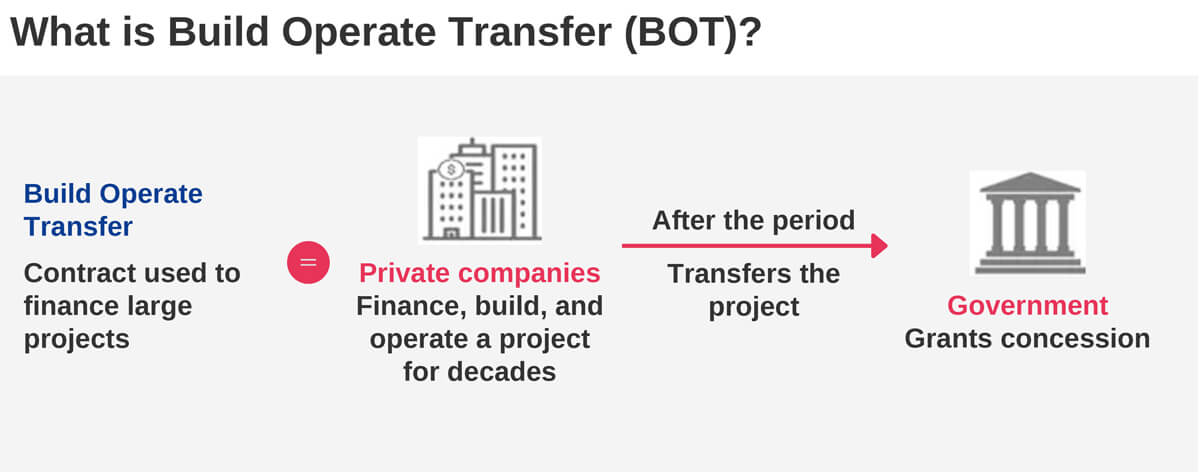
Explanation of Build Operate Transfer model. Available at: https://www.wallstreetmojo.com/buildoperate-transfer
Description
A Public Private Partnership (PPP) is a long-term contract between a government entity and a private entity for providing a publicly beneficial service or asset, where the private party bears some risk and responsibility. PPPs can be attractive for governments as they can transfer upfront costs to private partners, take advantage of external expertise, and open new financing options.
Build-Operate-Transfer (BOT) is a type of PPP model where the public sector grantor grants a private company the right to develop and operate a facility or system for the project period, in what would otherwise be a project fully developed and operated by the public sector from the start. The private sector operator finances, owns, and constructs the facility or system and operates it commercially for the project period, after which the facility is transferred to the government. The operator generally obtains its revenues through a fee charged to the utility/government, rather than tariffs charged to consumers.
The BOT model is an output-based contract where the contractor is accountable for meeting the contract outputs. BOT contracts are typically long-term contracts with operational service periods of 20-30 years. BOT contracts are typically suitable for large-scale, greenfield projects. They are typically used to develop a discrete asset (e.g., a toll road) rather than a whole network (e.g., an entire transport network).
Enabling Conditions and Key Considerations
- Legal and regulatory framework for PPPs: A robust legal and regulatory environment in the project’s country is crucial for structuring PPP projects, including BOT projects. This framework should define private sector investment rights, ensure transparent procurement, outline arbitration processes, and establish measures for bankruptcy/payment defaults. Clear delineation of enforcement capacities among institutions is essential. The regulatory framework not only creates business opportunities for private investors but also influences transaction speed, pricing decisions, and legal certainty in contractual arrangements and rule of law enforcement.
- Public sector expertise in design and implementation: Successful PPP implementation relies on an effective institutional framework that clearly delineates roles and responsibilities across ministries and coordinating bodies. This enhances efficiency and ensures effective enforcement of PPP agreements, fostering the overall success and sustainability of collaborative ventures between the public and private sectors. Public sector capacity is particularly critical in BOT projects where the government undertakes a competitive bidding process to identify an appropriate private sector operator based on factors such as experience, technical competence, and financial viability.
- Competent private sector providers: PPP will only be successful if the private sector has the capability to add value to the delivery of public services. Hence, PPP should only be applied to projects where the private sector has the competencies to meet the service standards required by the government or the public. This is particularly important in a BOT model where the private entity is responsible for financing the construction and operation of the asset and making it commercially viable. Even though the government serves as the primary client in paying tariffs for the utility, the commercial viability of the BOT project is essential for the private sector operator to fulfill its financial obligations, attract investment, and manage risks effectively, thereby ensuring the successful and sustained delivery of services.
Potential Challenges
- Lack of public sector capacity to implement PPP frameworks: Inadequate public sector capacity in policy formulation and regulatory management may hinder the creation of a robust PPP legal/regulatory framework and discourage private sector participation. Additionally, limited public sector capacity in planning and managing PPP projects may result in poorly structured contracts, unclear risk allocation, and diminished appeal for private investors. In particular, BOT projects demand a high level of expertise and oversight from the public sector such as the development and enforcement of transparent and fair bidding and evaluation procedures and the resolution of potential disputes during implementation to ensure that the full benefits of the BOT model are realized. As BOT projects involve multiple parties, they require robust interlocking contracts and careful regulatory oversight to safeguard public interests, which can be challenging to implement and monitor effectively.
- Lack of private sector capacity and limited participation: Limited capacity within the private sector may pose challenges for contractors to adhere to legal and regulatory frameworks, leading to bottlenecks and delays in project implementation. This issue is particularly significant in a BOT model where the operator, overseeing the entire project life cycle, may be unable to meet contractual obligations and regulations, and delay the construction and operation of the utility/facility. In addition, the large capital outlays and long timescales required to generate returns in BOT projects pose high risks for private investors. The perceived high-risk profile may result in limited interest from private investors, potentially leading to a reduced pool of potential partners for BOT projects.
- Risk of potential service discontinuity: If the contractor faces financial challenges during the contract, service continuity might be compromised if the government or alternative private providers are unable to take over and continue delivering the service. This challenge is particularly relevant for BOT projects, where there are high costs of changing operators given the complex nature of transferring responsibilities and potential legal complexities.
- Risk of loss of control during the operation phase: The government may experience a reduced level of control and decision-making authority during the operation phase as the private sector operator oversees the day-to-day processes.
Potential Benefits
- Potential for cost efficiencies: Private sector contractors, tasked with overseeing various project phases of design, build, maintenance, and operation, are incentivized to optimize lifecycle costs for long-term cost efficiency. This results in enhanced value for the public sector, as the private sector providers prioritize maintaining high-quality standards while minimizing lifecycle costs. This is particularly pertinent in BOT projects as the projects are conducted in a fully competitive bidding situation and are thus completed at the lowest possible cost.
- Private sector contractors are incentivised to deliver optimal outcomes: Private sector contractors are incentivized to deliver optimal outcomes as they seek to meet and exceed performance targets across various project phases. This results in enhanced service quality, timely project delivery, and the effective long-term management of public assets, ultimately benefiting both the public sector and end-users. In particular, the BOT model provides a mechanism and incentives for enterprises to improve efficiency through performance-based contracts and output-oriented targets.
- BOT projects can support accelerated infrastructure development: BOT projects facilitate the timely development of critical infrastructure by leveraging private sector expertise, funding, and operational efficiency. This results in not only faster project completion but also ensures that essential infrastructure is rapidly developed to meet the growing demands of society, enhancing overall community well-being.
- Supports risk transfer from the public sector: In a BOT project, the private sector operator assumes responsibility for all the construction and operational risks during the project period. This strategic risk transfer not only mitigates potential financial burdens on the public sector but also fosters a sense of accountability within the private sector, incentivizing them to implement robust risk management strategies.
Sources/Additional Information
- ERIA (2008). Build-Operate-Transfer for Infrastructure Development. Lessons from the Philippine Experience. Available at: https://www.eria.org/uploads/media/Research-Project-Report/RPR_FY2007_2_Chapter_11.pdf
- World Bank (2020). Concessions Build-Operate-Transfer (BOT) and Design-Build-Operate (DBO) Projects. Available at: https://ppp.worldbank.org/public-private-partnership/agreements/concessions-bots-dbos
- ADB (2011). Appropriate Financial Instruments for Public-Private Partnership to Boost Cross-Border Infrastructural Development-EU Experience. Available at: https://www.adb.org/sites/default/files/publication/156136/adbi-wp281.pdf
- MOF (2018). Public-Private Partnership Handbook Version 2. Available at: https.//www.mof.gov.sg/docs/default-source/policies/procurementprocess/ppphandbook2012.pdf
- PPIAF (2009). Main types of PPP. Available at: https://www.ppiaf.org/sites/ppiaf.org/files/documents/toolkits/highwaystoolkit/6/pdf-version/1-13.pdf
- ADB (n.d.). Public-Private Partnership Handbook. Available at: https://www.adb.org/sites/default/files/institutional-document/31484/public-private-partnership.pdf
- Drishtiias (2022). Build – Operate – Transfer Model. Available at: https://www.drishtiias.com/daily-updates/daily-news-analysis/build-operate-transfer-model-1
- WallStreetMojo (n.d.). BOT Model. Available at: https://www.wallstreetmojo.com/build-own-operate-and-transfer/#Advantages-and-Disadvantages
- MadDevs (2023). BOT delivery model in tech companies. Available at: https://maddevs.io/blog/bot-delivery-model-in-tech-companies/
- Al-Azemi, K. F., Bhamra, R., and Salman, A. F. M. (2014). Risk management framework for build, operate and transfer (BOT) projects in Kuwait. Available at: https://journals.vilniustech.lt/index.php/JCEM/article/view/3139/2602


